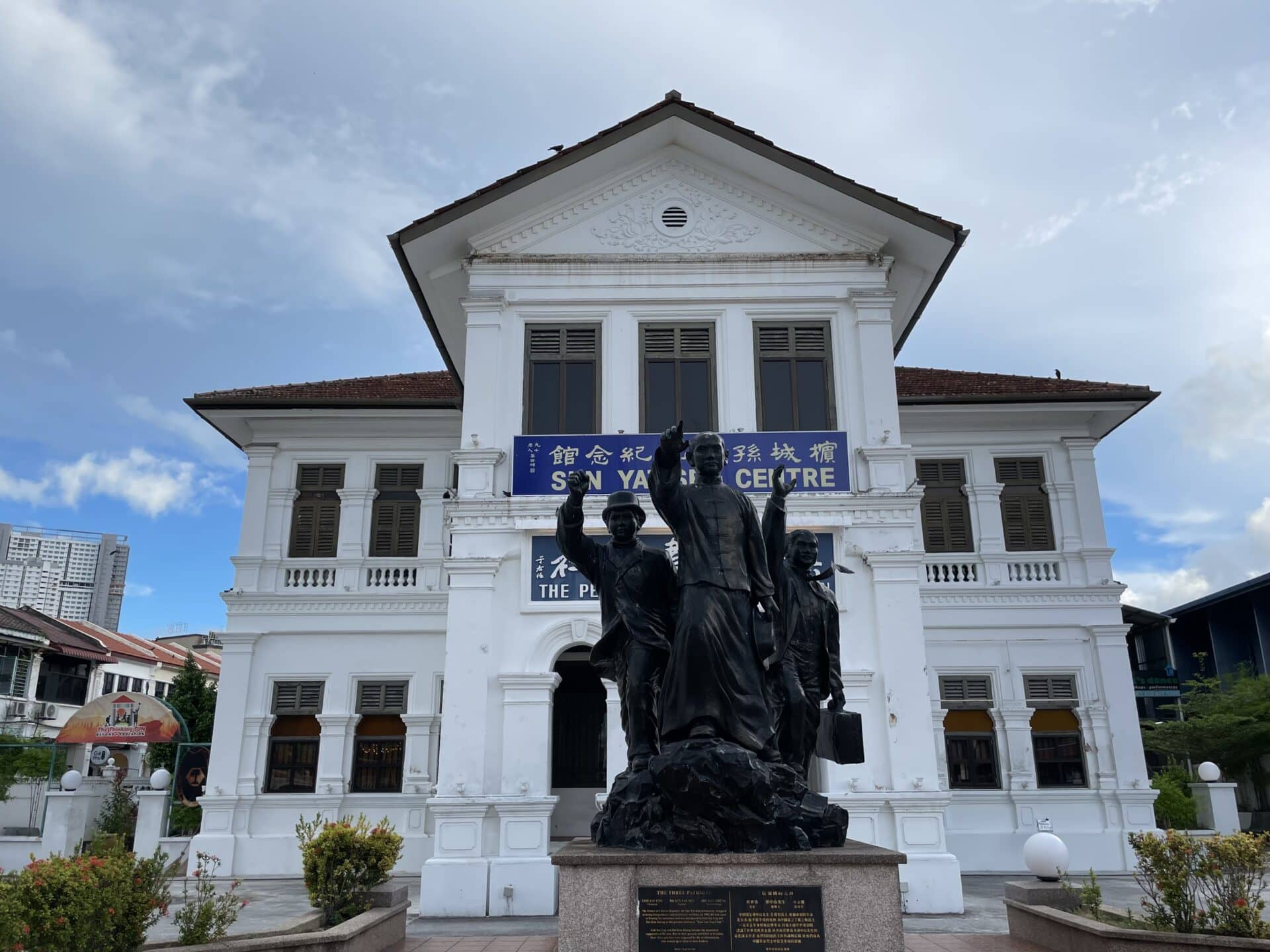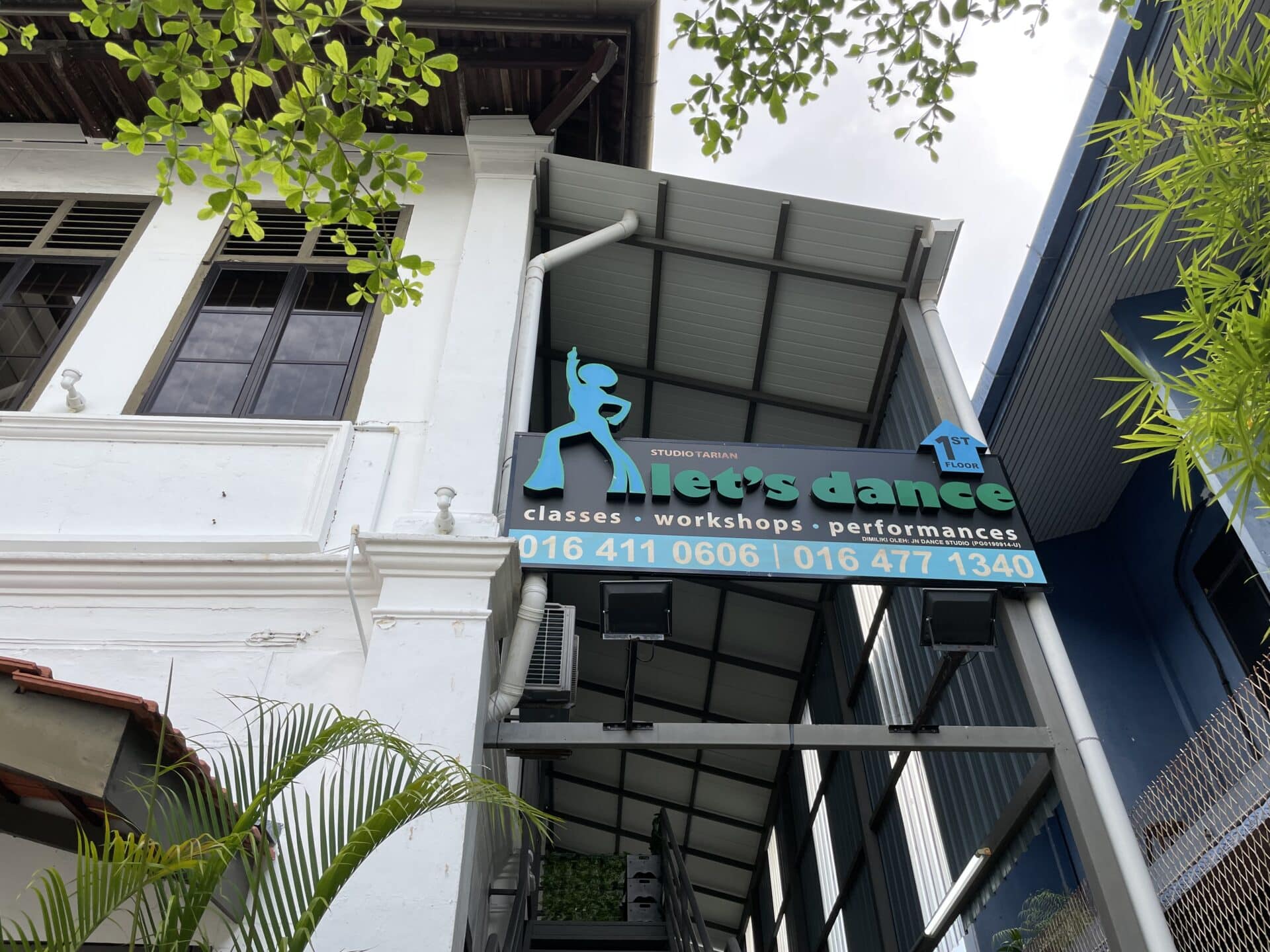Photo: Sofea Lee
Let’s Dance Studio | 2,230 words
The first thing I observe about the Sun Yat-sen Memorial Centre is the gleaming statue of three figures in the parking lot. Sun Yat-sen himself stands in the middle, stern and imposing, flanked by two Penangites who supported his political movement in China. It strikes me as odd that a building that pays such homage to historical figures would also host contemporary dance classes. As I pass the revolutionaries, they seem to give me the side-eye, questioning if I have any higher purpose this evening than to shake my butt. (I do not.)
I avert my gaze, quickening my pace until I finally spot a sign saying “Let’s Dance Studio” tucked away on the quieter side of the building.
I walk into class and immediately notice a woman, presumably the instructor, tinkering with the audio setup. The speakers are already blaring out a song, heavy on the bass. The woman glances up and smiles at me with a kind look in her eyes. Then she asks if I am Chinese.
I hesitate, guessing at the reason for her question. “Well, yes—I’m mixed—but I don’t speak any Chinese,” I reply, wearing an apologetic expression.
“It’s okay—but sorry ah, my English not very good, primary school level only. Can still follow?”
I give her a thumbs up. “Can. But I don’t have heels yet, it’s okay ah?”
“Yes, yes, first time, right? Can just wear socks and see first.”
I know what I signed up for. This class is called heels dance, a newer style blending the fluidity of jazz and the swagger of hip hop with four-inch stilettos. These moves are going to be somewhat provocative, and if I understand anything about the demographics of Penang, I will likely be the only one present who doesn’t speak Mandarin (that is, beyond counting from one to ten, and even then with no guarantee of getting the tones right). Malays make up the majority in the other Peninsular Malaysian states, but in Penang, we represent the largest ethnic minority after the Malaysian Chinese majority. I had a feeling that my fellow Malay Muslims would feel uncomfortable with this kind of physicality in a semi-public setting. And if the class was going to have a Chinese majority, I figured I would probably be the sole reason for our teacher having to switch to English.
I find I am right on all counts.
This will be interesting, I muse to myself.
Not only do I lack the proper shoes for this class, I also lack any prior experience learning dance in a formal setting. I simply want to pick up a hobby I have always wanted to explore, with zero stakes. The social conditioning that dominated the bulk of my childhood and adolescence left me with perfectionist tendencies that later seeped into college assignments, job duties, and even leisurely pursuits. I’ve begun wondering if it will ever be possible for me to enjoy doing something without needing to be good at it.
In early 2021, when work grew demanding, I tried picking up tennis to remind myself that I had an identity outside the thirty Excel spreadsheets I was manipulating at any given time. The physical activity did breathe life into my muscles, stiff from neglect. But I still felt clumsy and awkward, always holding up the racket like a sword and parrying each ball that came my way like I was warding off the blows of my enemies. The effort began to feel pointless. Sure, I didn’t have to be excellent at the sport, but ideally I would have liked to be able to serve or return a serve and get an actual match started on a reliable basis.
Now, two years later, this dance class feels like the tentative renewal of a promise to myself: a chance to learn something new without clinging to high expectations about results. A beginner’s mind.
*
We spend the first ten minutes stretching together. I sneak glances at my classmates to see if they are more or less flexible than I am and proceed to feel more or less superior as a result. Then I feel guilty, judging myself for judging them. I keep in mind that I’m here because I’m trying to let go of such punishing standards of perfection. Also, I quickly find that these deceptively simple mobility drills are leaving me winded. When everyone suddenly descends into a full split, I falter and struggle to lengthen my hamstrings in a desperate attempt to keep up.
Our instructor, Xin Ling, asks the other dancers to introduce themselves for my benefit. The women stand tall in their high, high heels and go down the line: Phelia, Shannle, Celine, Prisila, Lilian. Xin Ling makes sure we are ready to start before saying to me, “I explain in Mandarin first ah…”
In Penang, linguistic segregation begins early. The international schools provide an English-medium education and the private Chinese high schools yield Mandarin-dominant students, with public schools producing a variety of outcomes.
I attended a Malay-medium high school where I spoke mostly English with my circle of close friends and Malay with most of the others. When I graduated and started classes at a local tertiary college, I was shocked to realize that nine out of ten students around me did not feel comfortable using English or Malay, and instead conversed almost exclusively in Mandarin. Only then did I grasp how much I had taken being able to easily communicate with other Malaysians for granted.


Language dominance in Penang is not wholly divided along ethnic lines. Many Chinese students attend Malay-medium public schools like I did, where all four of the nation’s main languages can be heard in the canteens and among friends. But the numerous high-performing Chinese schools in the state naturally produce an abundance of Mandarin-dominant speakers. The average Penangite knows, on an intellectual level, that the state is ethnically diverse. However, actually living a cross-cultural life remains a different thing entirely.
This multilingual landscape that has endured for generations has resulted in a colorful and fragmented community. You could conduct all your daily affairs in Mandarin and live a full and rewarding life here, but you could also say that about folks who don’t speak any Chinese dialects and instead use a combination of Malay and English in their day-to-day lives, like I do. This quirk no doubt occurs in many heterogeneous societies, where entire swaths of the population have no reason to collide with one another on a meaningful basis save for bureaucratic concerns in government offices, the one place a single language typically prevails as the medium of paperwork and applications.
Lucky for me, even before my tertiary education I had plenty of life experience as the only person in the room who neither spoke nor understood the dominant language. As a child, whenever we visited extended family in Kedah, I barely caught any of the words in the Malay dialect unique to Bongor, my mother’s hometown. Aunts and uncles teased me often, knowing how I struggled to follow their conversations, but no one ever paused to explain themselves. It took me years of listening and guesswork to eventually learn the strange tongue. And during Chinese New Year in Negeri Sembilan, I would always sit quietly and peel one orange at a time while relatives on my father’s side chattered away in rapid Cantonese. However, I felt no pressure to pick up the language myself since most of my Chinese family members could use English with me.
As I grew older, I started to see that all the awkwardness I felt served as a training exercise of sorts. These situations were simply microcosms of Malaysian society at large. Yes, English was my true linguistic home, but I was learning that my discomfort did not have to prevent me from showing up in these spaces; that people weren’t kicking me out even though I never knew half of what was going on; and that I might as well stick around and learn something.
When I Googled “heels dance Penang” in mid-January and found this dance studio, I didn’t hesitate before registering for a trial class.
*
A month after I sign up, I fully commit to the cause and purchase black dance heels. Xin Ling relies on the other students to translate specific pointers or certain body parts for me: make sure your toes point forward so the legs look long; chest up and out when you arch your back so you make the curve more obvious. In return, I learn a few practical words in Mandarin: your (singular: nǐ de; plural: nǐmen de), can (kěyǐ), very (hěn), big (dà), and butt (pìgu), enabling me to get the gist of instructions like “your butts need to be very big here”. What is language if not a means of functional communication?
My integration into this small group is happening as organically as I could have hoped for. It’s a two-way street: if I am willing to put myself out there and brave the uncharted waters of a heels class in mostly Mandarin, with no background in either the dance or the language, then they’re willing to welcome me into the fold.
Depending on the level of difficulty, some instructors choose to teach choreography for a new song each week. Xin Ling prefers covering one song per month. This works well for me—we master dance moves in fifteen-second increments, building up toward one minute’s worth of choreography at the end of four classes. The songs are usually R&B, with their sensual lyrics lending the appropriate amount of spicy energy to the moves. We covered a dancehall-influenced track once, and the sight of us petite Southeast Asian women trying to twerk almost brought me to delirious tears.
Again, this class is not one that you would ordinarily catch a hijab-wearing woman like myself attending—perhaps in the more urban capital Kuala Lumpur, but less so in Penang. But funnily enough, heels dance presented itself to me as the best and most conservative option among other alternatives. I wanted to master rhythm and feminine sensuality in movement without a) requiring a dance partner as needed in Latin dances, and b) risking injuries to joints and muscles like I would probably be doing with pole dancing. I could think of no other dance styles I was interested in pursuing, so this class seemed to me like a godsend.
I am falling in love with heels dance more and more every week. In theory, the formula is straightforward, the payoff near-instantaneous: just follow instructions and you will be rewarded with the satisfaction of having pulled off some hot dance moves. This isn’t meant to be intellectual work. For someone not used to practicing much physical coordination beyond running or lifting weights in a static position, these classes have forced me to truly focus on the experience of inhabiting my whole body during class.
Dancing gets me out of my head. The mindfulness required to strut around in heels is astonishing. And I have released the need to be perfect while I learn, because I am having too much fun learning.
*
After class one evening, as we take off our heels and chat among ourselves about weekend plans, Xin Ling pauses and switches to English for me. Our classmate Lilian is leaving Penang soon to work in Dubai, and they are going out for a farewell lunch together.
“Want to join us?” she asks me.
I am delighted and readily accept the invitation. Lilian even messages me privately about any dietary restrictions on my part, which I appreciate immensely. The language barrier can perhaps be overcome, but there is no getting around the halal question. Food tends to serve as another (and perhaps the most important) shared language among Penangites, but the large number of delicious and historically non-halal eateries here represent yet another complication in bridging certain ethnic gaps.
We end up going to an upscale vegan cafe, where I learn what everyone’s day jobs are and how they began their own dance journeys. A couple of women speak mostly in Mandarin while the others switch between Mandarin and English and translate for us the entire time. And when it comes to this month’s song—a smooth Mandopop track by a Taiwanese artist—Xin Ling also takes care to translate each line so I can understand the meaning behind the movements she has been teaching us.
I still feel so moved by their simple acts of inclusive kindness.

Don’t get me wrong—it’s not like we’ve all turned into best friends after spending one hour together on Tuesday evenings. It’s just that the island feels that much smaller now, a bit more familiar in a pocket of town that was previously unknown to me.
Sometimes, the dividing line between insider and outsider is negotiable. It’s okay if I’m not part of every single conversation happening around me—it would be foolish to demand as much—but when it matters, I am never left out. In no other space do I cross paths with these women, but in this dance studio, a special kind of community building is taking place.
© Sofea Lee
Commissioning editor: Anna Tan






